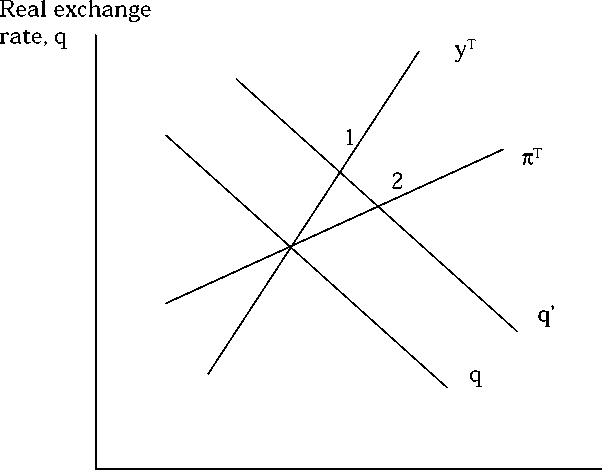The Interest Rate-Exchange Rate Link in the Mexican Float
Figure 4. Output and inflation targets under expansionary
depreciation.

Interest rate, i
the current period of peso floating. The results indicate that, even
considering a long lag structure, a weakening in today’s exchange rate
leads to a protracted increase in the interest rate differential. This
stands in contrast to an assumption commonly found in policy-oriented
macroeconomic models, and has potentially important implications.
In particular, given the discussion summarized in the previous
paragraph, the observed dynamic reaction of the peso interest rate
represents a stumbling block for the conduct of an anti-cyclical
monetary policy and compromises the output stabilizing properties of
the floating currency regime in the presence of capital account shocks.
It could be considered whether the results obtained are biased
by the single-equation estimation approach that has been followed.
As is well known, VARs are widely used in the field. However, in the
present context a VAR methodology was unattractive given the
purpose of studying the dynamic response of the interest differential
to an exchange rate change holding the rest as a constant, in
particular holding the policy stance unchanged. The intention was
25
More intriguing information
1. La mobilité de la main-d'œuvre en Europe : le rôle des caractéristiques individuelles et de l'hétérogénéité entre pays2. The Impact of Minimum Wages on Wage Inequality and Employment in the Formal and Informal Sector in Costa Rica
3. The effect of classroom diversity on tolerance and participation in England, Sweden and Germany
4. Palvelujen vienti ja kansainvälistyminen
5. The name is absent
6. Putting Globalization and Concentration in the Agri-food Sector into Context
7. The name is absent
8. INTERPERSONAL RELATIONS AND GROUP PROCESSES
9. Olfactory Neuroblastoma: Diagnostic Difficulty
10. Non Linear Contracting and Endogenous Buyer Power between Manufacturers and Retailers: Empirical Evidence on Food Retailing in France